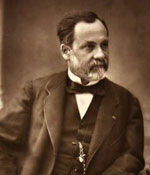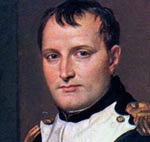
Louis Pasteur was born in Dole, Eastern France. He was a conscientious and hard-working student, though not considered exceptional. One of his professors called him ‘mediocre’. He received a doctorate in 1847, and after obtaining posts at Strasbourg, Lille and Paris, he spent much time researching aspects of Chemistry. One key discovery related to research on tartrate acid showing the crystals contained a mirror image of right-handed and left-handed isomers.
His most important discoveries were in the field of germ study. He showed that germs required certain micro-organisms to develop; using this knowledge, he found that the fermentation of yeast could be delayed. Louis Pasteur then turned to practical ways of killing bacteria in liquids such as milk. His process of pasteurisation successfully killed bacteria in milk without destroying milk protein. This was a radical discovery and made drinking milk safe. The process of pasteurisation was named after him, and it saved many lives.
Louis Pasteur was a great believer in hard work, never content to rest on his laurels he continued to work very hard in his laboratory to develop more cures. He said in advice to other scientists:
“An individual who gets used to hard work can thereafter never live without it. Work is the foundation of everything in this world.”
In the 1870s, Louis Pasteur sought to find a cure for anthrax – a disease that mainly affects cattle. Firstly, he found anthrax was much more likely if farmers buried dead sheep with the disease in fields. Pasteur was able to advise farmers not to bury any dead animals in areas where cattle may graze in the future. In 1881, he conducted an experiment to implement his vaccine for anthrax, which was successful. The previous year, in 1880, Jean-Joseph-Henri Toussaint, a veterinary surgeon, used carbolic acid to kill anthrax bacteria. Pasteur used a similar method, but his greater fame gave him the bulk of the credit and commercial demand.
The success of a cure for anthrax encouraged Pasteur to develop a cure for rabies – a very common disease at the time. Using similar principles, he developed a weakened strain of the disease. Testing on animals affected with rabies was successful; however, he was reluctant to test on humans for fear it might not work. At one point he considered testing on himself – subjecting himself to rabies and then trying his cure. However, before he could implement his scheme, a young boy was brought to him who had been bitten 14 times by a rabid dog. His parents agreed to try the uncertain new technique. His treatment was a success and news of the treatment soon spread. Over 350 people came to Louis Pasteur for treatment. Louis and his team of scientists worked around the clock to save the people who had contracted rabies.
There was only one failure a ten-year-old girl Louis Pelletier. Louis knew the dies ease was too advanced when she came, but, he tried nevertheless. The girl died in his arms, with tears in his eyes, the great scientist said to her parents.
“I did so wish I could have saved your little one.”
In 1888, friends and supporters funded an institute for the treatment of rabies. Louis Pasteur successfully campaigned for better research facilities for scientists. His pleas for more funding were heard by Napoleon III. Louis Pasteur argued that:
“Physicists and chemists without laboratories are like soldiers without arms on the battlefield.”
Louis died in 1895 aged 73. On his last day he remarked:
“I should like to be younger, so as to devote myself with new ardour to the study of new diseases.”
Louis Pasteur had great faith in the good nature of humans. He worked tirelessly to deliver real benefits for the treatment of infectious diseases. More than any other person, Louis Pasteur helped to increase average life expectancy in the late nineteenth and early twentieth Century.
Achievements of Louis Pasteur
- The process of Pasteurisation making milk safe to drink
- Cure for Rabies
- Cure for anthrax
- His principles were used by later scientists such as Frankland, Valley Radot, Emile Duclaux, Descours and Holmes in developing vaccines for diseases such as typhus, diphtheria, cholera, yellow fever and different strains of plague
Citation: Pettinger, Tejvan. “Biography of Louis Pasteur”, Oxford, UK. www.biographyonline.net, 18th Feb. 2008. Last updated 17th March 2017.
Louis Pasteur: Founder of Modern Medicine
Louis Pasteur: Founder of Modern Medicine at Amazon
Related pages
 Famous Scientists – Famous scientists from Aristotle and Archimedes to Albert Einstein and Charles Darwin. Including mathematicians, biologists, physicists and chemists.
Famous Scientists – Famous scientists from Aristotle and Archimedes to Albert Einstein and Charles Darwin. Including mathematicians, biologists, physicists and chemists.



